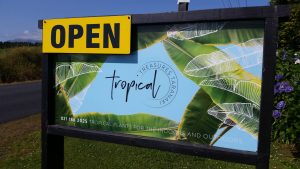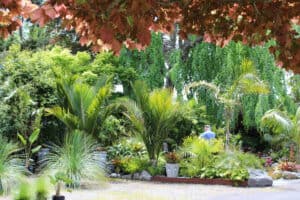Tropical Treasures now have a range of subtropical fruit trees available in New Plymouth. Kiwi gardeners can grow subtropical fruit trees – as long as they are in the right area, we can help you create your very own subtropical food forest at home.
We supply many other varieties as they become available in the right season, be sure to follow us to see what’s in stock.
Available at Tropical Treasures today.
Banana Misi Luki
Has beautiful green foliage and is highly disease resistant. Tight bunches of delicious lady finger bananas, short and fat and very sweet.
Habit
Bananas are very easy to grow. It is tolerant of drought and poor soils. Ideal family is one mother plant with 2-3 daughter plants. Once a plant has fruited cut it down and chop into pieces and add as mulch around the daughters.
Size
Quick growing, reaching an approximate height of 3-4m.
Pollination
Flowers in autumn and is self-fertile. The flower stalk appears out of the centre once the plant is fully grown. It hangs down as the flower develops. The male flower develops at the end of the flower stalk creating a bell. The female flowers spiral around the stem. The female flowers are white tubular with rich nectar purple bracts and deep red within.
Harvest
Harvest in spring. Once a bunch of bananas has developed remove the bellflower. This will make sure the energy is put into fruit development. Harvest the bunch once the oldest bananas start to yellow and hang up in a shed to ripen. Or harvest fruit individually as they tree ripen in spring. This is ideal in cooler climates. They have a good shelf life.
Landscape Value
Wonderful luscious tropical leaves are great as a backdrop or centre piece to your garden. Plant against a house, around a pool or in a courtyard.
Nutritional Value
A good source of ascorbic acid (Vitamin C), Vitamin A, Vitamin B6, Potassium, with some calcium and iron. They are low-salt, low-fat and are cholesterol-free.
Expected Yield
One bunch of bananas per mother plant.
Loquat Kaitaia Gold
Clusters of woolly white perfumed flowers in winter followed by yellow round/oval juicy fruit. The skin is smooth and slightly hairy. Excellent flavour with a good balance between acid and sweetness. The flesh is firm and has an apricot/plum flavour. Each fruit contains 2-8 large brown seeds. Trees can be biennial bearing.
Habit
Very attractive compact tree with large dull rich green leaves, long and pointed, thick, stiff, waxy and shiny above with a felty underneath.
Size
6-9m
Pollination
Self-fertile.
Harvest
Pick fruit Springtime (November to December), when it has changed colour to deep golden yellow, to ensure maximum taste and sweetness is obtained. It takes 3-4 years to fruit.
Landscape Value
They are very attractive, with large glossy leaves and fragrant flowers in late autumn-winter. Great in a container for the smaller garden, or as a specimen tree in the large garden. The round-headed trees can be used to shade a patio. Loquats also make attractive espaliers.
Nutritional Value
Fruits are high in vitamin A (but poor in vitamin C) and has good levels of potassium.
Mountain Paw Paw
Native to South America and is commonly found growing around mountain villages, hence its name. Also known as Vasconcellea pubescens.
Habit
Large distinguished evergreen leaves up to 60cm across and deeply lobed. There is a coating of hairs on the underside of the leaves. The flowers and ripening fruit are fragrant and the deeply lobed leaves make this paw paw as ornamental as it is delicious.
Size
Quick growing round-headed small tree, growing 2-4 metres.
Pollination
The fruit is produced within 2 years if male and female flowers are present. Male and female flowers may be produced on the same plant or separate plants. A plant may vary from male to female during the year. Therefore, to ensure pollination, more than one plant is needed. The white/green waxy flowers are borne in the leaf axils.
Harvest
Harvest when the fruit turns yellow and slightly softened, late winter to early summer.
Landscape Value
Highly ornamental as a sub-tropical planting around the courtyard where the aroma from the fruit can be appreciated. Choose an area where leaf drop is not a problem.
Nutritional Value
Unripe fruits can be eaten as a vegetable but ripe fruits always contain more vitamins and minerals. They contain vitamin A, B, C and iron. The leaves may have cancer-fighting properties.
Expected Yield
One tree may produce up to 50-60 fruits per season.




